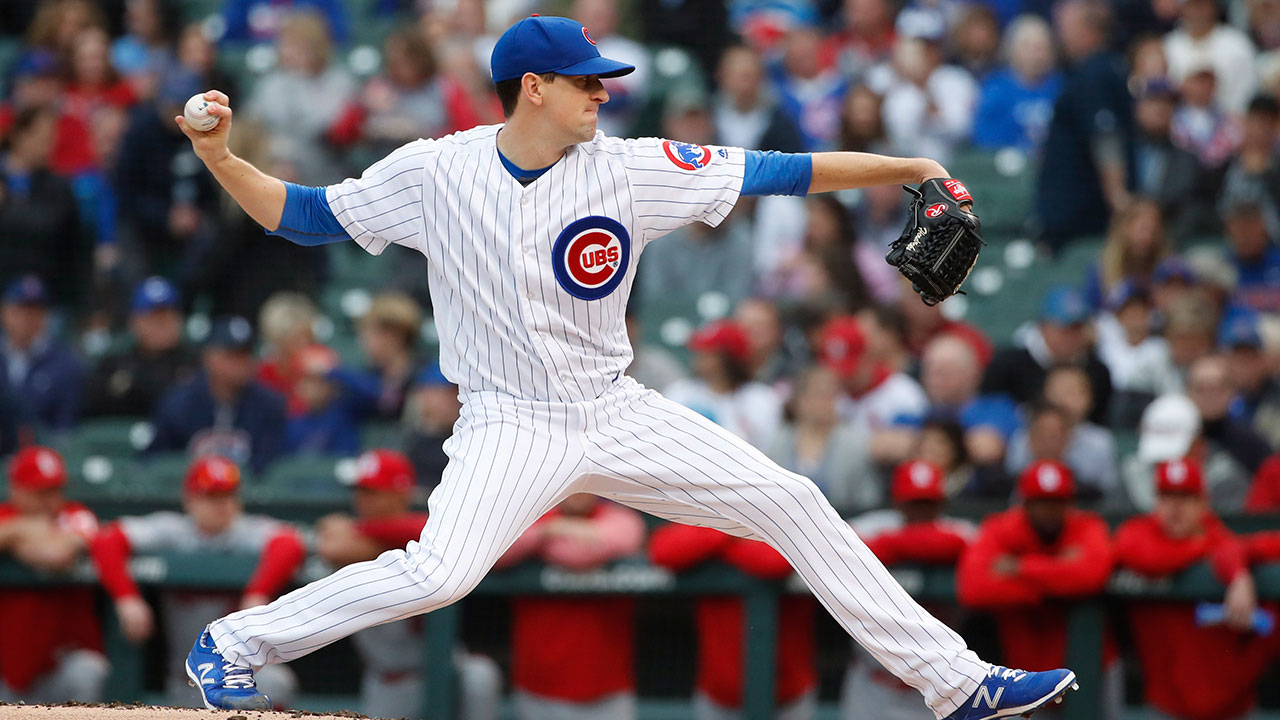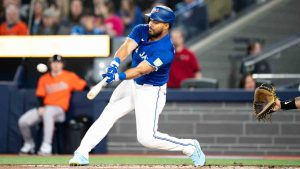Yesterday, we looked at two teams — the Oakland Athletics and Cincinnati Reds — the Toronto Blue Jays ought to be calling early and often this off-season. Both clubs could be motivated to move controllable, front-line starters. And the Blue Jays have the prospect capital to get deals done with either.
But big trades like those are harder to pull off than you might think. Discussions can stall for a million reasons. Sometimes the price is too high; sometimes the rival front office doesn’t value your prospects the way you do; sometimes you get outbid.
Plus, Oakland and Cincinnati are under no obligation to make a move. They could opt to hold, let those pitchers contribute to what they hope are winning teams, and re-evaluate at the trade deadline. That’s why the Blue Jays will cast a much wider net as they seek to fill two rotation holes and several in their bullpen. They can’t cut themselves off from any opportunity to improve.
So, let’s consider where some of those alternative options could lie. Here are five other clubs the Blue Jays could line up with this winter in trades for under-the-radar arms. All arbitration estimates herein are sourced from Matt Swartz’s model published by MLB Trade Rumors.
[snippet id=5196472]
Miami Marlins
Trade target: Elieser Hernandez
The Marlins haven’t been shy about their desire to add a catcher — and the Blue Jays happen to have four young, controllable options on their 40-man roster. With Toronto on the hunt for pitching, and Miami sitting on a stockpile of young arms, there ought to be a way for these two teams to address one another’s needs.
It’s hard to envision Miami wanting to subtract from its controllable rotation core of Sandy Alcantara, Trevor Rogers, and Pablo Lopez — but how about Elieser Hernandez? Mixing strong fastball command with a swing-and-miss slider and an emerging changeup, the 26-year-old has pitched to a 3.84 ERA with encouraging strikeout (26.3 per cent) and walk (5.7 per cent) rates over 77.1 innings since the beginning of 2020.
That innings total is so low because Hernandez’s career has been repeatedly derailed by injuries — first a lat strain in 2020, then biceps and quad issues in 2021. The Blue Jays would certainly prefer a pitcher who’s shown more durability. But it’s worth noting that neither his shoulder nor elbow have been issues.
Hernandez’s home-run rate — he’s allowed 2 HR/9 for his career — is another red flag. But that could be addressable with a pitch usage tweak if the tendency doesn’t normalize on its own over a larger sample. And if Hernandez can put together a healthy season in 2022, all other arrows point to a breakout candidate.
Is there a deal to be built around a framework of Alejandro Kirk for Hernandez? It’s certainly worth exploring as the Blue Jays work through their options. Projected to earn only $1.4-million in his first trip through arbitration this winter, Toronto could come away with a bargain if they can help Hernandez miss more barrels and stay on the field.
[snippet id=3305549]
Chicago Cubs
Trade target: Kyle Hendricks
Plunging head-first into a rebuild, the Cubs sold off anything that wasn’t nailed down this summer — save for Kyle Hendricks, a command-and-control right-hander who’s owed $14-million each of the next two seasons, and carries a club option for 2024 valued at $16-million with a $1.5-million buyout.
Those are terms the Blue Jays should be able to fit in to future budgets. And considering Chicago’s relatively light payroll commitments going forward, it’s always possible Toronto could look to get the Cubs to pay some of Hendricks’ freight by offering to send higher upside prospects the other way.
The risk in a Hendricks outing is that the ball’s often in play. But the Blue Jays took a significant step forward defensively in 2021, going from 2020’s second-worst team by DRS to an above-average club, which should give its front office more confidence rostering a pitcher who will annually contend for the league’s lowest fastball velocity and strikeout percentage.
That counterintuitive mix works because Hendricks generates soft contact at an elite rate and hardly walks anybody, which is how he posted xERA’s below four every season from 2015 through 2020. This year was a slight departure from those results, as Hendricks’ xERA was 4.96 and his actual ERA ended up at 4.77. But the soon-to-be 32-year-old still finished in MLB’s 88th percentile or higher in walk rate, hard hit rate, and average exit velocity, indicators that suggest he was just as accurate and difficult to square up as ever.
That makes him a strong candidate to rebound to his career norms — and perhaps his depressed 2021 numbers mean he comes at a slight discount. There’s certainly no discounting his durability (Hendricks is top-10 MLB-wide in starts and innings since his debut in 2014), a trait the Blue Jays value highly. In tandem with a workhorse like Jose Berrios, Hendricks could give the Blue Jays valuable rotation certainty around Hyun Jin Ryu, whose 2021 suggested his workload will need to be more carefully managed going forward.
Houston Astros
Trade target: Jake Odorizzi
The Houston Astros haven’t received a great return on the two-year, $23.5-million guarantee they gave Odorizzi in March, as the right-hander battled forearm and foot issues while pitching to a 102 ERA+ over 104.2 innings this season. And he’s pitched only once so far during Houston’s postseason run — a four-inning relief appearance — after being left off the club’s ALDS roster.
At this point, Houston clearly has more confidence in homegrown rotation options Lance McCullers Jr., Framber Valdez, Luis Garcia, and Jose Urquidy. And if the Astros sign a starter, or Cristian Javier rejoins the rotation, or top pitching prospect Hunter Brown is ready to make his big-league debut, Odorizzi could find himself outside Houston’s rotation picture.
Maybe that motivates the Astros to look for a way to unload Odorizzi and redeploy the remaining money he’s owed. And maybe the Blue Jays could take a reasonable gamble on a 31-year-old with five pitches who’s delivered dependable, mid-rotation innings throughout his career.
The return? Well, the Astros could use a centre fielder after losing George Springer last winter and trading Miles Straw in July. And Toronto has a spare one in Randal Grichuk. What if the Blue Jays and Astros exchanged risks by swapping players on guaranteed deals who underperformed their career norms in 2021?
The trade framework could be complex, as Odorizzi’s contract was creatively structured to help keep the Astros below MLB’s competitive balance tax threshold. While Grichuk currently has more guaranteed money remaining on his deal, Odorizzi could potentially end up being owed more if he surpasses a series of performance escalators.
That could require some “if X then A; if Y then B” wording in an agreement if the clubs want to make it a salary neutral one. But those are the kind of numbers MLB franchises pay their front offices to crunch. And there’s always the option of sending a prospect or international bonus money in either direction to even things out.
However they handle the fine print, there’s potential upside here for both sides — each trading an underperforming veteran from a position of surplus to make a bounce back bet in an area of need.
Arizona Diamondbacks
Trade target: Merrill Kelly
Since returning from Korea in 2019, Kelly’s been quietly eating innings (372.2 IP) at a league-average clip (4.27 ERA) with the Diamondbacks, who hold a $5.25-million club option on him for 2022. That would be an extremely cheap price to pay for another 2.4 fWAR campaign like the one Kelly produced this year. And Kelly’s WAR could’ve been even higher if he hadn’t missed more than a month after testing positive for COVID-19.
So, the Diamondbacks will surely pick up Kelly’s option. But with the franchise staring down the barrel of a rebuild in a hyper-competitive division, its front office could choose to cash in Kelly’s value this winter for a prospect or two it likes, rather than risking him getting injured or underperforming ahead of next summer’s trade deadline. Toronto ought to make a call and see what that price would be.
Admittedly, acquiring Kelly wouldn’t be a sexy move. The 33-year-old doesn’t miss a ton of bats and he’ll allow his fair share of hard contact. But if the Blue Jays are looking to fill out the back end of their rotation at a discount in order to deploy payroll towards other roster needs, they could do a lot worse. Kelly throws five pitches for strikes, leading to a terrific 5.8 per cent walk rate over the last two seasons. And he’s been stellar for stretches, like 2020 when he pitched to a 2.59 ERA over five outings before thoracic outlet syndrome ended his season.
Kelly obviously wouldn’t be the focal point of Toronto’s off-season strategy. But if the club added a higher-priced, higher-upside starter via free agency or trade, he could provide rare certainty at a bargain out of the No. 5 slot in the club’s rotation.
[snippet id=4722869]
Pittsburgh Pirates
Trade target: Chad Kuhl
As was the goal of its methodical tear down over the last several years, the Pittsburgh Pirates have zero guaranteed contracts on the books for 2022. But what Pittsburgh does have is a 40-man roster crunch that could motivate its front office to deal a couple arbitration-eligible veterans this winter to create room to protect its minor-league talent from the Rule 5 draft.
One of those players could be Kuhl. After sitting out three weeks mid-season when he tested positive for COVID-19, the 29-year-old career starter shifted to a relief role, which helped the right-hander’s fastball play up into the mid-to-high 90’s. Pairing that with a high-spin curveball and a slider that generated whiffs 33.5 per cent of the time, Kuhl showed flashes of promise in his new role.
Yes, he allowed 10 earned runs over 13.1 innings as a reliever — but five of them came in a single appearance that lasted only a third of an inning. Remove that blow-up spot and Kuhl pitched to a 3.46 ERA with a 31.5 K%.
Considering the quality of his stuff, it’s reasonable to expect Kuhl to pitch better in 2022 with the benefit of a full spring training to focus on his new relief role. And with a projected salary of just $3-million in his final year of arbitration eligibility, Kuhl could represent a cost-effective way for the Blue Jays to add much needed firepower to the back end of their bullpen.
[relatedlinks]






COMMENTS
When submitting content, please abide by our submission guidelines, and avoid posting profanity, personal attacks or harassment. Should you violate our submissions guidelines, we reserve the right to remove your comments and block your account. Sportsnet reserves the right to close a story’s comment section at any time.